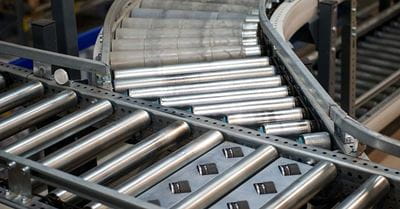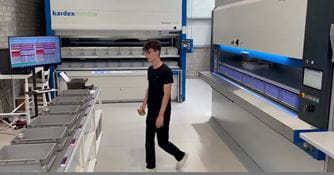Sortation Systems | Nogales

Raymond West supplies a full range of conveyor and automation products, including all types of sortation solutions.
To speak with an automation expert, phone us at (520) 281-4125.
Are you considering a sortation solution for your Nogales warehouse, distribution center or manufacturing facility? The most popular kinds of sortation systems vary greatly in ability and cost. In this article we offer a high level overview of the advantages and shortcomings of the three most popular types of sortation systems.
Cross-Belt Sorter & Tilt Tray Sorter
Cross-belt and tilt-tray sorters offer similar capability and are commonly lumped together when discussing sortation automation. However, they are very different mechanisms.
Tilt-tray sorters are a series of trays mounted to carts that are transported on a continuous-loop conveyor. Items are put into the trays at one or more induction positions on the loop via manual or automatic processes. When a product arrives at its sorting location, the tray that is transporting it tilts and deposits the item toward a chute.
Cross-belt sorters are powered belt conveyors added to carts running on a continuous conveyor loop. Comparable to tilt-trays, cross-belt sorters drop items onto a chute when they reach the appropriate sorting destination.
Advantages: Cross-belt and tilt-tray sorters provide the best sorting speed and can manage a wide variety of product types in comparison with other sortation systems. They are a terrific option for operations that handle a wide array of SKUs. These kinds of systems are likewise fairly noiseless and permit a more pleasant work environment for warehouse personnel.
Disadvantages: The speed, capacity and versatility or these sorters come at a price-- they are among the most expensive sortation choices offered.
Shoe Sorter
Sliding shoe sorters employ a "shoe" mechanism attached to the conveyor surface that pushes and diverts items onto a secondary, after-sort conveyor. Shoe sorter solutions receive goods from a unified flow of products that may be a combined feed from numerous upstream areas of a warehouse. These kinds of sortation solutions are widely utilized in shipping applications.
Advantages: Sliding shoe sorter configurations can accommodate a fairly high peak rate, often several hundred units per minute, depending on the item weight and dimensions. Furthermore, a wide range of items can be handled due to the simplicity and flexibility of a positive divert system.
Disadvantages: Shoe sorters are more costly than other alternatives like pop-up wheel sorters. In addition, divert centers are not readily movable, making the system difficult and costly to reconfigure. These systems also generate more noise than belt or tray solutions and are therefore not as worker compatible as other styles of sorters.
Pop-up Wheel Sorter
Pop-up wheel sorters are a popular option because they are fairly low-cost and simple to implement. Wheels or rollers are incorporated into a belt conveyor. When an item needs to be diverted, the wheels quickly rise up to shift items at an angle to a secondary, downstream conveyor.
Advantages: Pop-up wheel sorters are modular, so segments can be rapidly added or eliminated when the system requires modification. These systems can also be significantly less expensive than other sorter options.
Disadvantages: These types of sorters deliver far less performance and capacity than cross-belt, tilt-tray or shoe alternatives. They will undeniably boost efficiency, but might not multiply total output like other alternatives. Because pop-up systems don't use a positive divert, the kinds of items they can process are reduced.
Automated Sortation Systems Near Me
To get more details on sortation choices, phone an automation professional at Raymond West Inc today!
Raymond West Inc
2725-B North Grand Ave
Nogales, AZ 85621
(520) 281-4125
You May Also Like:

Conveyor Repair | Nogales
Raymond West is a Nogales warehouse automation equipment supplier. We offer repair and service for many types of conveyor systems. Call us today at (520) 281-4125.
Learn More

Order Picking Systems | Nogales
We design, install and maintain state-of-the-art order picking solutions for all types of warehouse and distribution center operators.
Learn More

Pallet Shuttles
We supply a full range of warehouse automation equipment including pallet shuttle systems. If you'd like to find out more about automation possibilities for your warehouse, give us a call today.
Learn More

Pick To Light Solutions | Nogales
Pick to light systems are efficient, high throughput systems that can transform your warehouse and increase profitability.
Learn More

